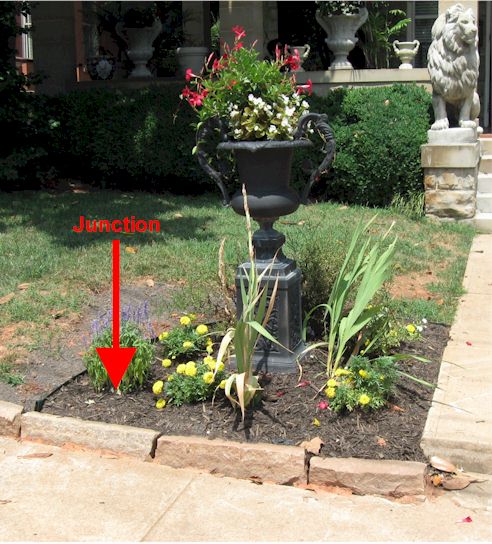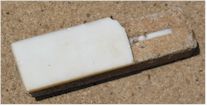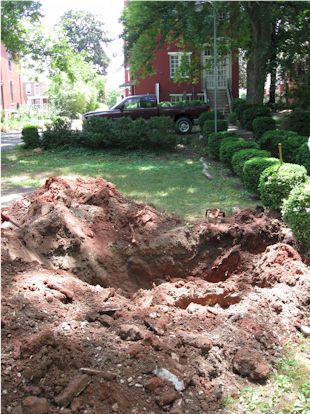Mystery Waters
On Thursday, July 8, 2010, Jeffrey reported a leak in the crawlspace at the W. F. Patton House. On inspection, Paul found a rusted ¾" galvanized pipe with an elbow on the end that had been cut many years before. While obviously decommissioned, water was now flowing from this pipe – not a drip and not a high-pressure gusher, but a steady and unexpected flow. Mystery water.
Further examination showed that this pipe rose from under the foundation through a brick wall. A small opening in that wall revealed this pipe was once connected to lead pipes leading upward. This must have been part of the original water supply for the Patton House.
 Jeffrey's
attempts to remove the rusted elbow and add a cap just broke the fragile old pipe.
The leak was ultimately stopped with a Dresser coupling fitted over the outside
of the pipe. Problem solved, or so we thought.
Jeffrey's
attempts to remove the rusted elbow and add a cap just broke the fragile old pipe.
The leak was ultimately stopped with a Dresser coupling fitted over the outside
of the pipe. Problem solved, or so we thought.
On Friday evening, just after supper, Marjory and faithful Bichon Fletch found a swamp in the rear yard next to the concrete path lined by boxwoods. Paul's initial digging did not reveal the source of this mystery water.
A call was made to the Danville Water Department, thinking that both mysterious leaks might be caused by a second supply line to the property – perhaps from the rear on Grove Street. The man from the water department didn't think so. More importantly, he advised that the water meter in the front sidewalk was spinning. A search of every sink and toilet showed water was not being used in the House.
Paul sought information and advice from the House's former owner, Dr. Wilford Cocke. Wil reported that he had made no changes to the water supply. The black polyethylene pipe feeding the House was there on his arrival more than 35 years ago. Wil also offered that there were remains of extensive formal gardens that would have required a source of water when he purchased the property.
With visions of a gigantic water bill dancing in their heads, Paul and Marjory began digging in the rear yard again early on Saturday morning. A PVC pipe oozing water was found below grade, and a valve was attached to stop the flow. Problem solved? The water meter continued its relentless turning.
Mid morning, Jeffrey joined the search. Speculation was that there must be a Tee in the line from the meter to the House feeding an ancient leaky pipe to the rear yard. Two exploratory holes near the foundation showed only the 1" black pipe – no leaks and no Tee. By lunchtime, the diggers were exhausted. Clearly, a new approach was needed.
A decision was made to start a new search beginning near the water meter. By two o'clock, the diggers equipped themselves with a small rented backhoe. An hour later, a growing mound of earth on the sidewalk showed only a lack of success in finding the pipe from the meter to the House.
At last, the black pipe was sighted about a foot deeper and two feet west of its expected location. Tracing this pipe toward the sidewalk exposed a leak in the polyethylene pipe where it joined the city's soft copper feed line. By five o'clock, the leak was repaired, and the water meter had stopped turning. By six, the mound of earth had been returned to its hole.
No Tee to the rear yard was found, yet opening the valve installed that morning continued to produce a small flow of water – without registering on the meter. Mystery water!

On Sunday morning, the landscaping over the front-yard hole was restored. By this time, the flow of water in the rear yard had stopped. However, a decision was made to solve the mystery – to dig further in the rear while the backhoe was available.
Following the pipe in the rear yard proved every bit as difficult as finding the pipe in the front yard, as it was about four feet below grade. After a short while, the backhoe hit something very solid, which Jeffrey tried to dig around.
 What
the backhoe first exposed was a circular foundation that Paul estimated to
be eight to ten feet in diameter. A little further digging showed that this
foundation was of large granite blocks. This round "room" had a floor about
three feet below grade, with both the floor and walls lined by ceramic-faced
block. Because no water was found, the decision was made to fill this
hole after measurements were taken for future reference. The front-center
of this round foundation was approximately ten feet east of the concrete path and
96 feet from the rear wall of the house.
What
the backhoe first exposed was a circular foundation that Paul estimated to
be eight to ten feet in diameter. A little further digging showed that this
foundation was of large granite blocks. This round "room" had a floor about
three feet below grade, with both the floor and walls lined by ceramic-faced
block. Because no water was found, the decision was made to fill this
hole after measurements were taken for future reference. The front-center
of this round foundation was approximately ten feet east of the concrete path and
96 feet from the rear wall of the house.

It seems that the round room must have been a silo attached to the "carriage house" known to have stood in the rear yard. The ceramic blocks are often seen in stables for sanitary reasons. Having a silo, particularly such a large silo, suggests the building was more like a barn with other animals (perhaps a cow) in addition to horses. Finding the floor three feet below grade may mean that the rear yard has been filled substantially over the years. Perhaps before Grove Street was extended, the yard sloped into the ravine north of Grove Street now linked with a culvert.
Back to the beginning of this story, what was the source of the mystery waters? There is no certain conclusion. Clearly, the water was not flowing from an abandoned line to Grove Street. One idea was that there is an artesian well in the rear yard, flowing as the result of gravity. But if so, why did it stop flowing on Sunday, July 11?
Because of mysterious happenings at the Patton House, one can't help but wonder if the mystery waters appeared to alert the Liepes to their city water leak. However, the most likely explanation may be that water from the front-yard leak somehow made its way into the House's original plumbing. Most likely at least for now.
July 18, 2010 PCL
UPDATE: Late in the afternoon on Monday, July 19, the cold water valve in the third-floor bathtub failed, spewing water into the tub. Closing the cold-water shutoff valve for this bathroom on the second floor does not entirely stop the flow. (That valve is faulty as well.) The plumber installed new shutoffs on Tuesday, leaving the tub disconnected.
This strange happening has triggered renovations to the third-floor bath including removal of the fiberglass tub and surround, and reopening the door to the third floor hall. Immediately after opening this blocked doorway, Marjory and Fletch both heard noises that Marjory described as the sound of children playing.
Renovations will include removal of the "new" door to the second apartment bedroom, and exposing and restoring the wainscoting that originally clad this room. Refinishing and reinstallation of the claw foot tub found in the basement boiler room (most likely from this room) will commence shortly.
July 25, 2010 PCL